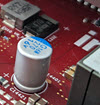
On Wednesday, November 22, we had our second CaSA, Computer and System Architecture Unraveled, meetup. Same place in Kista as the last time, the 25th floor of the Kista Science Tower building, thanks to the kind sponsorship of Vasakronan and our collaboration with Kista Science City. This time, the theme was networking – but not at the socket level. Per Holmberg presented how his team used “micro sleep” for power management in line-rate network processing, and Hans Brandberg talked about the Precision Time Protocol. Another great event!
Continue reading ““Packet Networks are not Socket Science” – Computer and System Architecture Unraveled Event Two” Back in 2004, the startup
Back in 2004, the startup  Once upon a time, all programming was bare metal programming. You coded to the processor core, you took care of memory, and no operating system got in your way. Over time, as computer programmers, users, and designers got more sophisticated and as more clock cycles and memory bytes became available, more and more layers were added between the programmer and the computer. However, I have recently spotted what might seem like a trend away from ever-thicker software stacks, in the interest of performance and, in particular, latency.
Once upon a time, all programming was bare metal programming. You coded to the processor core, you took care of memory, and no operating system got in your way. Over time, as computer programmers, users, and designers got more sophisticated and as more clock cycles and memory bytes became available, more and more layers were added between the programmer and the computer. However, I have recently spotted what might seem like a trend away from ever-thicker software stacks, in the interest of performance and, in particular, latency. After a long break, this is another blog post in the series of “how to do modeling for virtual platforms”. The previous installments dealt with
After a long break, this is another blog post in the series of “how to do modeling for virtual platforms”. The previous installments dealt with